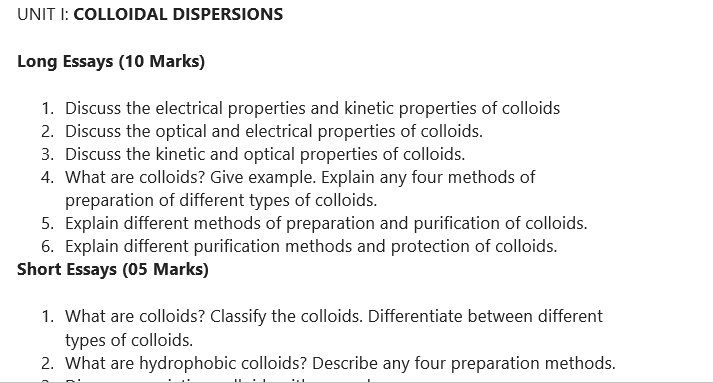Physical pharmaceutics-2 question bank released by rguhs Bangalore. It contains all the important questions according to the syllabus of physical pharmaceutics-2 also PCI regulations.
Table of Contents
Physical pharmaceutics-2 (B pharmacy 4 sem) question bank for all units

UNIT I: COLLOIDAL DISPERSIONS Physical pharmaceutics-2 question bank.
Long Essays (10 Marks)
- Discuss the electrical properties and kinetic properties of colloids
- Discuss the optical and electrical properties of colloids.
- Discuss the kinetic and optical properties of colloids.
- What are colloids? Give example. Explain any four methods of preparation of different types of colloids.
- Explain different methods of preparation and purification of colloids.
- Explain different purification methods and protection of colloids.
Short Essays (05 Marks)
- What are colloids? Classify the colloids. Differentiate between different types of colloids.
- What are hydrophobic colloids? Describe any four preparation methods.
- Discuss association colloids with example.
- Explain protection of colloids.
- With the help of a neat labeled diagram explain methods for purification of colloids.
- Explain optical properties of colloids
- Explain kinetic properties of colloids
- Explain electrical properties of colloids.
- Explain DME and its applications.
- Explain the concept DLVO theory with energy curves. How this theory is applied in stabilizing the colloidal dispersion.
- What are association colloids? Mention the mechanism of formation of micelles with suitable example.
Short Answers (02 Marks)
- State and explain Hardy schulze rule
- What is craft point?
- Define and classify colloids.
- What are association colloids?
- What is gold number?
- What is Tyndall effect
- What is zeta potential? Give example.
- What is nernst potential? Give example.
- What is electro osmosis and electrophoresis?
- What is streaming potential?
- Explain the term colloid and mention its applications.
- Explain condensation method of preparation of colloids.
- What is meant by protective colloids? Mention one example for the same.
- Explain Hofmeister series with example
- List the effect of mixing different types of colloids.
UNIT II: Rheology
Long Essay (10 Marks)
- Define and explain Non Newtonian flow of liquids
- Define Newtonian flow of liquids. Explain shear thinning system of liquids
- Define Thixotropy. Explain different methods for its determination and give its application in pharmacy.
- Define the mechanism of thixotropy and give its applications in pharmacy.
- Define Viscosity. Classify different viscometers with examples. With the help of neat diagram explain the principle and working of any one single point viscometer.
- Define Viscosity. Classify different viscometers with examples. With the help of neat diagram explain the principle and working of any one multipoint viscometer.
- With the help of neat diagram explain the working principle of Cup & bob and Cone & plate viscometer with its advantages and disadvantages.
Short Essay (05 Marks)
- Explain the Newtonian system of flow with examples
- Explain Plastic and dilatant flow of liquids
- Discuss plastic and pseudoplastic system of flow
- Explain shear thickening system with examples
- Explain the mechanism of thixotropy with examples
- Explain the methods to determine the thixotropic behavior of liquids.
- Explain the principle of cup & bob viscometer
- Explain the principle of Ostwald’s viscometer
- Explain the physical stability if suspension.
- Explain the different methods to evaluate the stability of suspensions.
Short Answer (02 Marks)
- Define Rheology. Give any two applications
- Describe a Rheogram and Rheopexy
- What is yield value? Give its applications
- Define dilatancy with examples
- Define Newton’s law of flow with equation
- Give examples for plastic and pseudoplastic system of flow
- What is Negative thixotropy
- What are Bulges and Spurs
- Explain Bulges with example.
- Explain Spurs with example.
- Define Viscosity along with its units of expressions
- What is plug flow? How do you overcome it.
- Define microemulsions and multiple emulsions
- Draw flow curve for anti-thixotropy flow and explain its mechanism.
- Explain the terms shear thinning and shear thickening system. Give example for each type of material.
Unit III: Coarse Dispersions
Long Essays
- Explain in detail interfacial properties of suspended particles.
- Discuss formulation parameters of suspension.
- Discuss in detail the theories of emulsion.
- Define emulsion. Explain in detail rheological properties of emulsions.
SHORT ESSAYS
- Explain the formulation of emulsion by HLB method.
- Classify emulsions with examples.
- Write a note on identification tests of emulsions.
- Settling of suspensions.
- Write a note on preservation of emulsions.
- Classify suspension with examples.
- Differentiate between flocculated and deflocculated suspensions.
- Write a note on phase equilibrium in coarse dispersions.
Short Answers
- Define suspensions
- Define emulsions
- Define phase inversions
- Differentiate between creaming and cracking.
- Stokes law
- Sedimentation volume
Unit IV: Micromeritics
Short answers (02 Marks)
- State Edmundson’s equation
- State stokes law
- Explain frequency distribution curve
- Explain normal distribution curve
- Explain percent log normal distribution curve
- What is polydisperse system
- What are equivalent diameters? Explain martins diameter
- Explain ferret diameter and projected diameter
- What is particle size distribution and particle number
- What is quantasorb. Explain its principle
- What are fundamental properties? Give examples
- What is bulk density ant true density
- Define angle of repose. Write its significance
- What is void volume and porosity
- What is granular density and true density
- What is compressibility index
- What is rate of flow of powder and explain carr’s index
- Give packaging arrangement of powders
- Define volume-surface mean diameter. Give the equation for its calculation.
- Define shape factor. What is its importance in micromeritics?
- List four methods to improve the flow properties of granules and powders.
- List the ways to characterize a powder
Short Essay (05 Marks)
- How do you represent particle size distribution
- Enumerate methods to determine the particle size. Explain any two methods to determine the particle size
- With the help of neat diagram explain Andreason’s pipette method to determine the particle size
- With the help of neat diagram explain principle and working of coulter counter method to determine the particle size
- What is specific surface area? How is it measured by air permeability method
- What are derived properties of powders? Explain any two
- Define angle of repose. Explain the method to determine the same
- Explain porosity. Give its applications in pharmacy
- Enumerate different methods of determination of true density and explain any one.
- List different types of densities of powder/granules. Write the experimental method for the determination of any one of them.
UNIT V: Drug stability
Long Essay (10 Marks)
- Define first order reaction with suitable examples. Deduce an equation for the determination of rate constant, half life and shelf life for first order reaction kinetics.
- Define Zero order reaction with suitable examples. Deduce an equation for the determination of rate constant, half life and shelf life for zero order reaction kinetics.
- Explain chemical degradation of pharmaceutical compounds due to hydrolysis. Explain its preventive measures.
- Explain chemical degradation of pharmaceutical compounds due to oxidation. Explain its preventive measures.
- Explain chemical degradation of pharmaceutical compounds due to hydrolysis and oxidation.
- Enumerate the different methods of determination of order of reaction. Explain any two methods in detail
- Define stability studies. Explain in detail how the shelf life of pharmaceutical product is determined.
- Give the objectives, salient features, methodology and limitations of accelerated stability studies.
Short essay (05 Marks)
- Explain the factors influencing the rate of a reaction.
- Explain the preventive measures for chemical degradation due to oxidation.
- Explain the preventive measures for chemical degradation due to hydrolysis.
- Explain the graphical and half life method for determination of order of reaction.
- Define order of reaction. Explain the substitution method for determination of order of reaction.
- Define order of reaction. Explain the differential method for determination of order of reaction.
- Explain physical degradation of pharmaceuticals and its preventive measures.
- Explain environmental factors affecting degradation of drugs.
- Define Arrhenius plot and give its significance in calculation of shelf life.
- Explain effect of temperature on rate of a reaction.
- Explain methodology to calculate shelf life of a drug with graphical representation.
Short answers (02 Marks)
- Define rate and order of a reaction
- Define molecularity of reaction with example
- Define pseudo zero order reaction with example
- Define pseudo first order reaction with example
- Enlist different methods of determination of order of reaction
- Define zero order reaction with suitable example
- Define first order reaction with suitable example
- Give expressions for rate constant and half life of zero and first order rate of a reaction
- Give expressions for rate constant and half life of first and second order rate of a reaction
- How are pharmaceuticals stabilized against hydrolysis
- How are pharmaceuticals stabilized against oxidation
- Define physical and chemical degradation with examples
- Enlist environmental factors affecting degradation of drugs
- Enlist various applications of chemical kinetics in pharmacy
- Give Arrhenius equation and its significance
- Define shelf life of a medicinal product
- Draw Arrhenius plot and mention its use
- Derive an expression for the time taken for 90% retention of potency for a zero order reaction
- Derive an equation to show that half life is independent of the concentration in first order reaction
- Explain why suspension mostly follow zero order
- Define half life. Explain concept of half life in first order reaction
